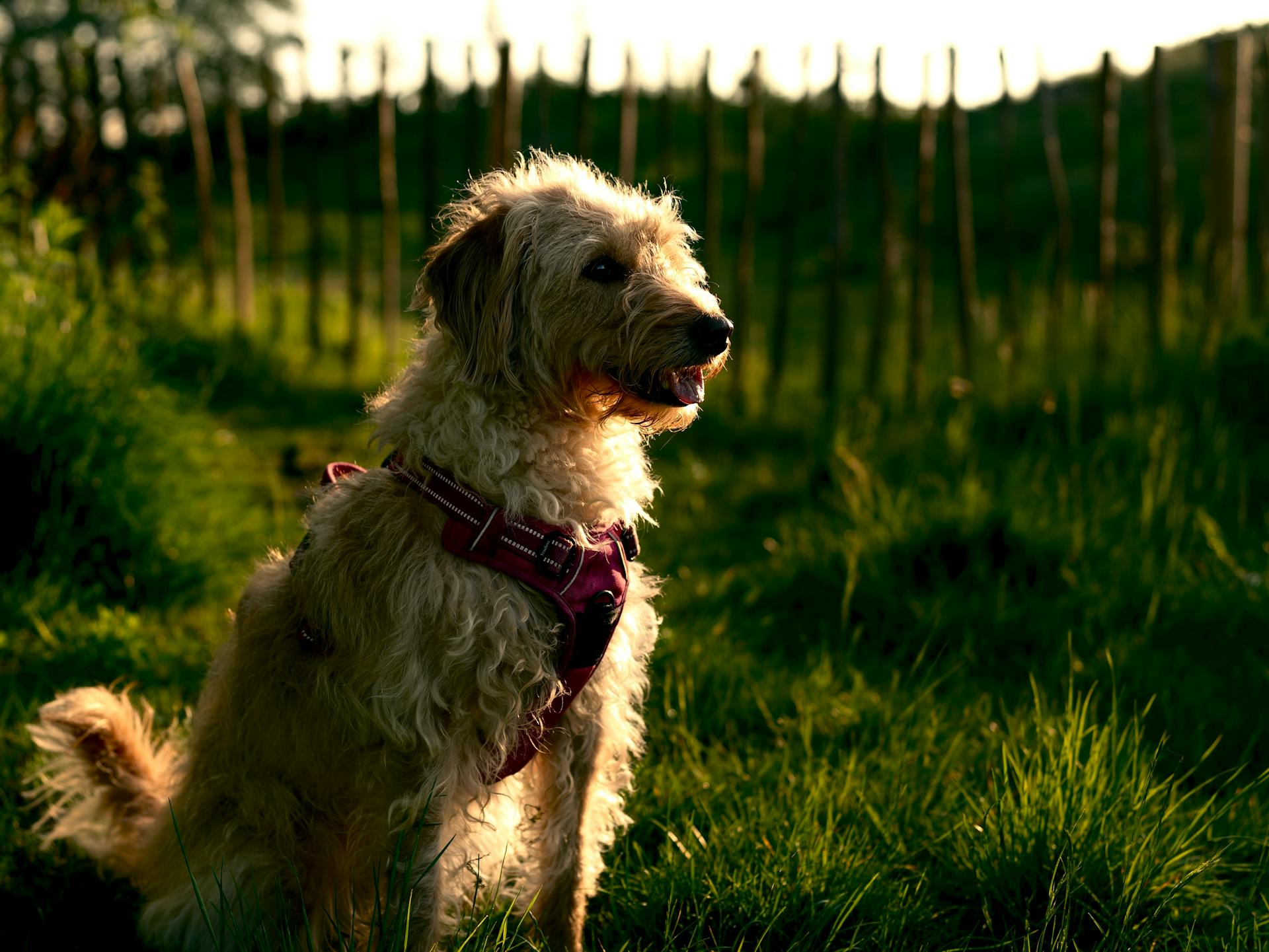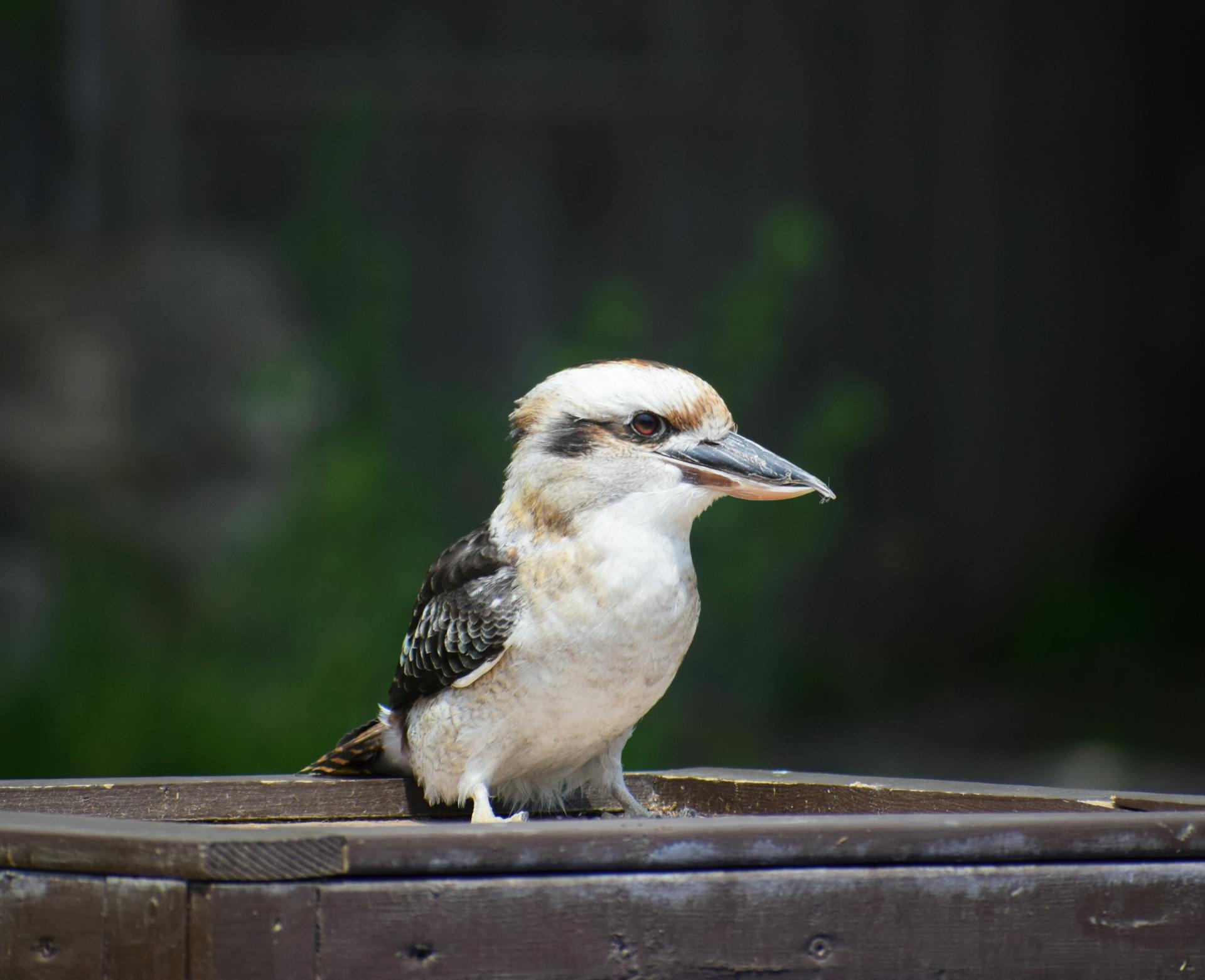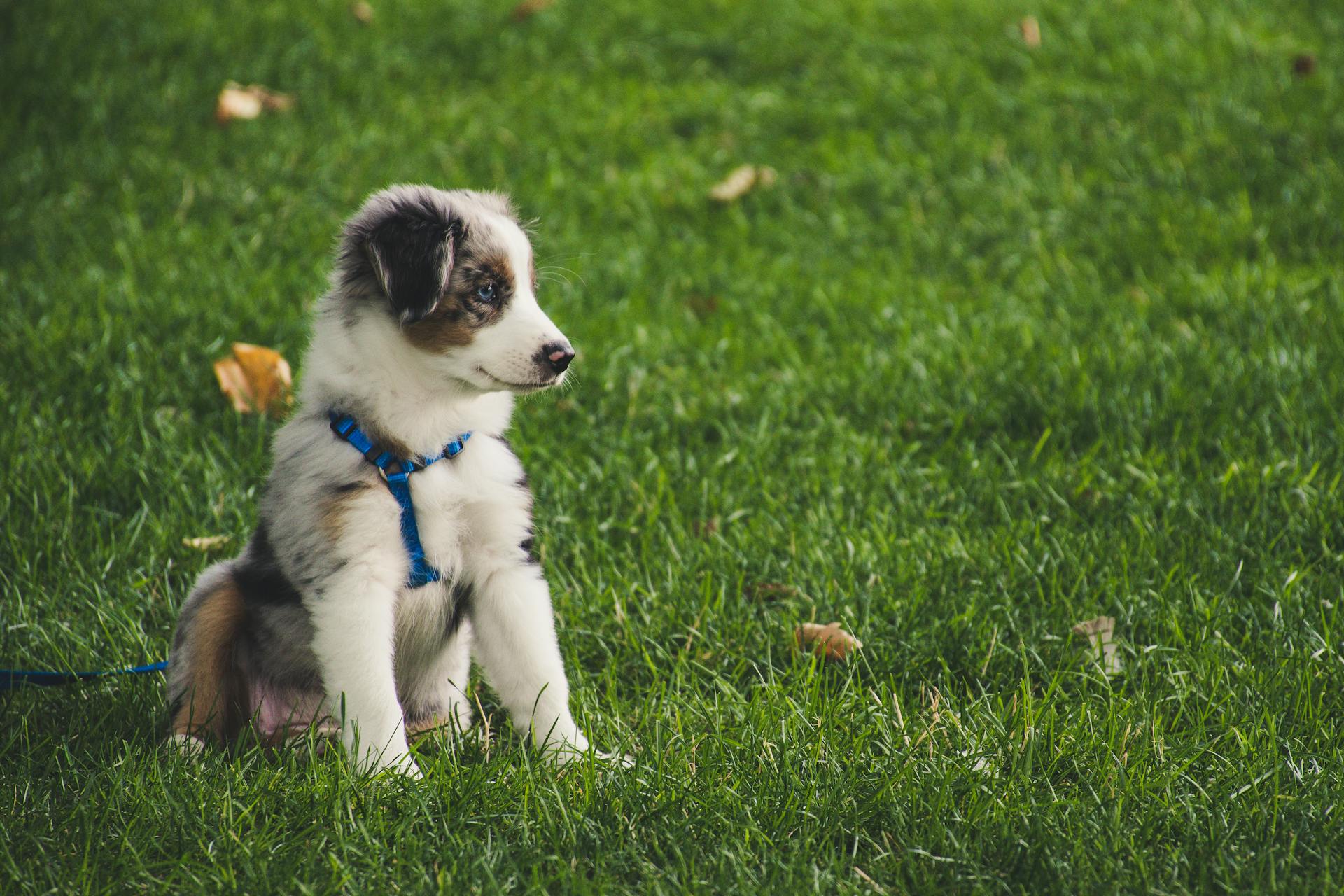
Australian Labradoodles are a popular breed, and for good reason. They're highly intelligent, friendly, and love to please their owners.
Originating from the 1980s, Australian Labradoodles were bred to be hypoallergenic and low-shedding, making them a great choice for families with allergies.
The History of
The Australian Labradoodle breed originated in the 1980s in Australia, specifically developed by Wally Conron while he worked at the Royal Guide Dog Association of Australia.
The breed was created to provide a guide dog for a blind client whose husband was allergic to dogs, but it's unclear if this was the first Australian Labradoodle.
The Australian Labradoodle's genetics are more complex than the regular labradoodle, with a lineage that includes up to six different dog breeds.
Here are some of the breeds that contribute to the Australian Labradoodle's unique genetics:
- Labrador retrievers
- Standard or miniature poodles
- Curly-coated retriever
- American cocker spaniel
- English cocker spaniel
- Irish water spaniel
The breed developers sought to create a dog that combined the best traits of these breeds, with a focus on creating a non-shedding coat.
Physical Characteristics
Australian Labradoodles are a medium to large-sized breed, and their size can vary depending on their lineage. They typically weigh between 20 to 70 pounds.
The Australian Labradoodle's height can range from 14 to 24 inches, with males being slightly larger than females. Their coats are short, soft, and curly or wavy.
Here's a breakdown of the Australian Labradoodle's typical size:
What Do They Look Like?
Australian Labradoodles are a unique and lovable breed, and their physical characteristics are definitely one of their most distinctive features.
Their height and weight can vary greatly, ranging from 14 to 24 inches tall and 20 to 70 pounds in weight, with males typically being larger than females.
One of the most recognizable features of the Australian Labradoodle is their coat, which can be short, soft, and curly or wavy.
Their coat colors can be quite varied, including brown, red, black, blue, gold, cream, and silver, and can appear in a range of combinations depending on their lineage.
Their faces are often described as resembling a "teddy bear", with large, round eyes and floppy ears that make them look endearingly cute.
Their tails are regular-sized, adding to their overall cuddly appearance.
Here are some key physical characteristics of the Australian Labradoodle:
Their lifespan is typically between 13 and 15 years, making them a long-term companion for many families.
Coat Types
Australian Labradoodles have a unique coat type that's a result of their poodle heritage. Their coats are typically short, curly, or wavy and are very low-shedding, making them a great choice for people with allergies.
One of the most distinctive features of the Australian Labradoodle's coat is its texture, which can be either fleece-textured or wool-textured. Fleece-textured coats are soft and can be straight or wavy, while wool-textured coats are, as the name suggests, like wool and are usually curly.
Their coats can appear in a range of colors, including black, red, brown, blue, gold, cream, and silver. You might also see a mix of colors, depending on their lineage and the coats of their parents.
Temperament and Personality
Australian Labradoodles are known for their pleasant temperament and generally sociable nature. They are friendly and outgoing, and love spending time with their families.
Early socialization is vital for this breed, as it helps prevent reactivity towards people or other dogs. Without proper exposure, they may develop reactive behavior towards perceived threats.
Australian Labradoodles are naturally playful and enjoy time with their human families. However, they should not be left alone or in crates for too long.
They are intelligent and quick to learn, making them easy to train. Consistent training from a young age is essential for enhancing their overall quality of life and yours as they grow into adulthood.
Australian Labradoodles are prone to separation anxiety and can act out if left alone for long hours during the day or night. This can be mitigated with plenty of exercise, attention, and training.
They are very active dogs and will need over an hour of daily activity to stay happy. This can include time outdoors, exercise, and playtime with their owners.
On a similar theme: Can Labradoodles Be Left Alone
Australian Labradoodles are loving and loyal to their families, forming strong bonds with their owners. They enjoy spending time with their owners, whether it's cuddling on the couch or going for a walk.
With proper training and socialization, Australian Labradoodles can thrive in a variety of situations and environments. They make great family pets, especially for families with children.
Behavior and Training
Australian labradoodles are known for their gentle and friendly nature, making them a great choice for families with children. They are not prone to aggression, but proper training is still essential to ensure good behavior.
Australian labradoodles are highly intelligent, which means they can pick up new commands quickly and love to learn new things. They are eager to please their owners, making them a joy to train.
Here are some key things to keep in mind when training your Australian labradoodle:
- They require regular exercise and mental stimulation to prevent behavioral issues.
- Basic obedience training is crucial to establish a strong bond and prevent unwanted behavior.
- They are prone to separation anxiety if left alone for long periods, so they need consistent care and attention.
Australian labradoodles are generally easy to train due to their intelligence and eager-to-please attitude. However, they still require consistent training and socialization to become well-behaved adult dogs.
Are with Kids?
Australian labradoodles are a great choice for families with kids. They're gentle and not prone to aggression, making them a wonderful addition to any family.
If you have young children, it's essential to teach them how to interact with dogs safely. With proper training and supervision, an Australian labradoodle will be a great companion for kids, enjoying playtime and activities together.
Australian labradoodles are also intelligent and easily trainable, which means they can learn to behave well around children. They're a great choice for first-time dog owners, too, as they're generally easy to handle and care for.
Here are some key traits to consider when deciding if an Australian labradoodle is right for your family:
Overall, Australian labradoodles can make wonderful family pets, but it's crucial to consider their needs and ensure you can provide the proper care and attention they require.
Are Aggressive?
The Australian labradoodle is not known for having an aggressive nature. They are generally gentle and friendly.
However, some Australian labradoodles may show signs of aggression or behavioral issues as puppies. Proper training is crucial to address these issues early on.
Separation anxieties can stem from being left alone during long hours, leading to behavioral issues. This is why it's essential to provide your dog with proper care and attention.
Proper training and care can reduce the chances of your Australian labradoodle developing behavioral issues. With the right approach, you can help your dog become a well-behaved and loving companion.
Explore further: Labradoodles Training
Do They Bark?
They don't bark a lot, and they're not known to be yappy. Australian Labradoodles are generally quiet dogs.
Like all dogs, they can bark from time to time, but this can be fixed with proper exercise, care, and toys for your dog.
Curious to learn more? Check out: Do Labradoodles Bark a Lot
Can Dogs Be Trained?
Dogs can be trained with ease, thanks to their intelligence and eager-to-please attitude. Australian labradoodles, in particular, are known to pick up new commands quickly and love to spend time with their owners learning new things.
Proper training is essential for any dog, but it's especially important for Australian labradoodles, as they can be prone to behavioral issues if left untrained. A good rule of thumb is to start with basic obedience training to cut down on the risk of behavioral issues.
Australian labradoodles are highly intelligent and can learn more advanced service-dog-style work, making them a great choice for first-time dog owners or experienced trainers alike. With patience, consistency, and positive reinforcement, you can teach your Australian labradoodle to be a well-behaved and loyal companion.
Here are some key training tips to keep in mind:
- Start with basic obedience training to establish a strong bond with your dog.
- Be consistent and patient, as Australian labradoodles can be prone to behavioral issues if left untrained.
- Use positive reinforcement techniques, such as treats and praise, to encourage good behavior.
Remember, every dog is unique, and what works for one Australian labradoodle may not work for another. With the right training and care, however, you can unlock your dog's full potential and enjoy a happy and healthy relationship.
Health and Care
Australian Labradoodles need at least 30 to 60 minutes of exercise daily, plus plenty of interaction with their families or toys, to prevent behavioral issues.
Regular veterinary visits, brushing a few times a week, and a high-quality diet are essential for their overall health and well-being. You may also need to take them to the groomers a couple of times a year to keep their coat clean and trimmed.
Some potential health issues to be aware of include Hip Dysplasia, Elbow Dysplasia, Cataracts, Drug Sensitivities, Epilepsy, Cold Tail, Ear Infections, and Obesity.
Here are some key health concerns to look out for:
- Hip Dysplasia
- Elbow Dysplasia
- Cataracts
- Drug Sensitivities
- Epilepsy
- Cold Tail
- Ear Infections
- Obesity
A spacious environment with room to roam and play freely is essential for their happiness and well-being, as they need a minimum of a 50-minute walk each day and enjoy indoor and outdoor play sessions.
Health Problems
Australian Labradoodles are generally a healthy breed, but like all larger dogs, they can be prone to certain health issues. Hip and elbow dysplasia are common problems that can arise in this breed.
Regular veterinary check-ups are essential to catch any potential health problems early on. Annual visits to the vet can help ensure your dog stays in top health.
Worth a look: Lab a Doodle Dog

Australian Labradoodles may also be susceptible to ear infections, allergies, eye abnormalities, Addison's disease, and epilepsy. These conditions can be serious, so it's crucial to monitor your dog's behavior and seek immediate care if you notice any concerning symptoms.
Some potential health issues to be aware of include hip dysplasia, elbow dysplasia, cataracts, drug sensitivities, epilepsy, cold tail, ear infections, and obesity. Being informed about these potential health concerns can help you take proactive measures to ensure your dog's well-being.
To reduce the risk of health problems, look for reputable breeders who prioritize the health and well-being of their dogs. Parents of Australian Labradoodles should have good hip and elbow scores, a recent clear eye test, and a clear screening for the bleeding disorder Von Willebrand's.
Here are some potential health concerns to consider:
- Hip Dysplasia
- Elbow Dysplasia
- Cataracts
- Drug Sensitivities
- Epilepsy
- Cold Tail
- Ear Infections
- Obesity
By being aware of these potential health issues and taking proactive steps to prevent them, you can help ensure your Australian Labradoodle lives a long and healthy life. With proper care and attention, your dog can thrive for 13 to 15 years or more.
Pet Care
Your Australian Labradoodle needs at least 30 to 60 minutes of exercise daily to stay happy and healthy.
They should also get plenty of time spent interacting with their families or toys to prevent boredom or behavioral issues. Leaving them alone for more than eight hours can trigger anxiety.
A 50-minute walk each day is ideal for this breed, supplemented by regular physical activity and mental stimulation. They love indoor and outdoor play sessions, such as fetch or tug-of-war.
Having a spacious backyard is essential for this active and playful breed, making apartment living not well-suited for them. They need room to roam and play freely to ensure their happiness and well-being.
Australian Labradoodles thrive on a high-quality diet, and you may need to take them to the groomers a couple of times a year to get their hair trimmed back. Regular brushing a few times a week is also crucial to keep their coat clean and untangled.
Low-calorie treats like sweet potatoes are a great option for training sessions, but it's best to consult with your veterinarian to determine the most suitable and balanced food for your furry friend.
Recommended read: How Often Do Labradoodles Need to Be Groomed
Do You Need to Groom?
You'll need to brush your Australian labradoodle at least once or twice a week to prevent tangles and mats in their fur.
Regular brushing will also help keep their coat clean and untangled, which is especially important since they don't shed much. Australian labradoodles typically need to be professionally groomed and trimmed a few times a year to keep their hair out of their eyes and their overall coat healthy.
Brushing your Australian labradoodle regularly will not only keep their coat looking great, but it will also help strengthen the bond between you and your dog.
Take a look at this: Labradoodle
Frequently Asked Questions
What is the difference between a Labradoodle and an Australian Labradoodle?
The main difference between a Labradoodle and an Australian Labradoodle is that the Australian Labradoodle is a cross between three breeds (Poodle, Cocker Spaniel, and Labrador Retriever), while the Labradoodle is a cross between only two breeds (Labrador Retriever and Poodle). This additional breed mix gives Australian Labradoodles a unique genetic makeup.
What is special about an Australian Labradoodle?
Australian Labradoodles are known for their gentle, loyal, and kind nature, making them a great companion for families. Their exceptional temperament is what sets them apart as a special breed.
Do Australian Labradoodles shed a lot?
Australian Labradoodles have a low to non-shedding coat, making them a great choice for those with allergies or a preference for low-maintenance grooming. This is due to their unique coat type, which is a blend of the lab and poodle coats.
What breeds make an Australian doodle?
An Australian Doodle is a crossbreed between a Poodle and an Australian Shepherd, but can also be made with other breeds such as the Labrador or English Cocker Spaniel. The exact breeds used can vary, but the goal is to create a friendly, intelligent, and low-shedding dog.
How much is an Australian doodle?
Australian Labradoodle prices range from $1,500 to $3,000, influenced by location and local demand. Learn more about the factors affecting Australian Labradoodle costs.
Sources
- https://dogacademy.org/breeds/australian-labradoodle
- https://dogtime.com/dog-breeds/australian-labradoodle
- https://www.lupinelanelabradoodles.com/about-australian-labradoodles
- https://providencehillaustralianlabradoodles.com/generations-australian-labradoodles-explained/
- https://www.thelabradorsite.com/australian-labradoodle/
Featured Images: pexels.com


